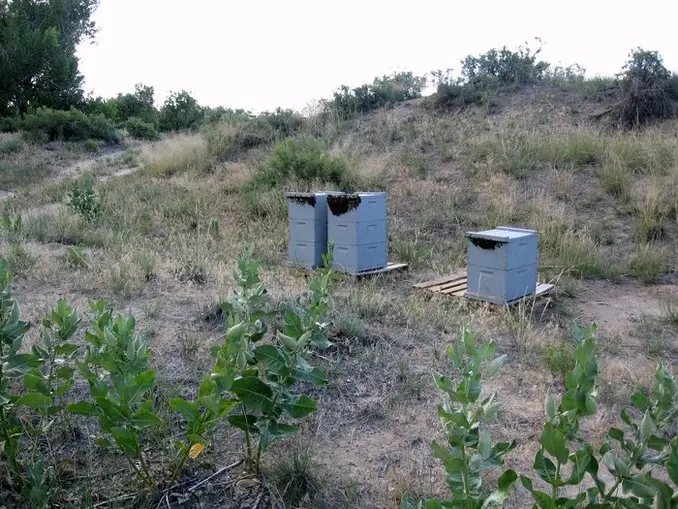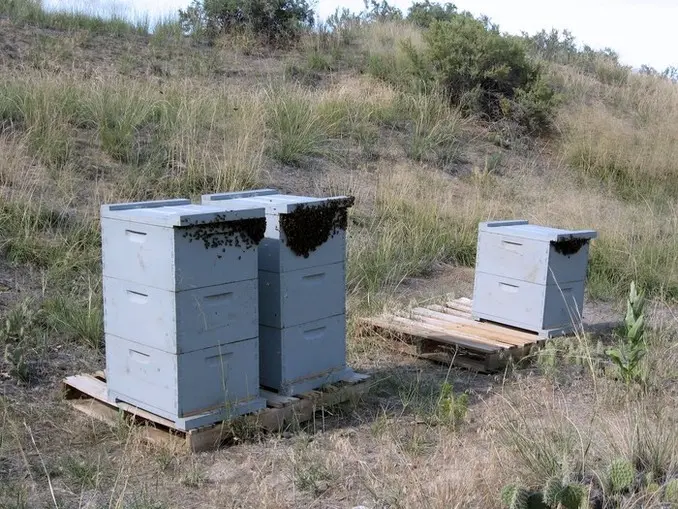Year 6 June - Embracing the Summer Buzz in the Bee Haven 🖊️

-Happy hives flaunting upper entrances, skunk-free havens.
June Delights: Busy Hives, Top Entrances, and a Hint of Wyoming’s Challenges
I’ve been on the road since May, and I’ll be honest, leaving my buzzing buddies to their own devices at this time of the year makes me a tad uneasy. But life’s twists and turns led me away, and this absence was etched into my calendar over a year ago. So, my bees have been holding down the fort solo.
While I was away, Wyoming decided it was time for summer. No gentle transition from spring, oh no. It’s the Cowboy State’s classic move – one day it’s snowing, and before you know it, you’ve got a scorching 90-degree day with skies so clear it’s almost surreal.
And wouldn’t you know it, the relentless drought is still our companion. Late-season snows gave the prairie a brief burst of green, but with July’s relentless sun, that green will vanish in the blink of an eye.
A Symphony of Good News
This update is a symphony of sweetness.
- Every hive boasts a reigning queen.
- The hot hive? Well, it seems to have found its chill with the new queen in charge.
- Combs are bursting with the golden goodness of sweet clover honey.
- Not a whisper of diseases or pests in sight.
- Those top entrances? Absolute game-changers.
- And, drumroll please, I remembered to pack my camera this time!
Top Entrances: A Beekeeper’s Aha Moment

-Behold the magic of using a migratory bottom board as a top entrance cover.
I’m sold on these nifty entrances.
- Skunk troubles? Non-existent.
- Ventilation? A breeze with fewer bees and less fanfare.
- Tidy bees? They keep those bottom boards spick and span, no matter where the entrance is.
- Plus, with a hint of smoke, they’re as zen as a hive with a bottom entrance.
Here’s the genius part – using a migratory bottom board as a cover:
- Gift-wraps a top entrance.
- Kisses goodbye the need for a separate migratory cover.
- Offers shelter to the entrance from sun and rain.
- Serves as a lofty spot for bees to cluster when hanging out.
- Provides stability during hive movements.
Dealing with Drought: A Beekeeper’s Odyssey
Drought is the evergreen woe for a Wyoming beekeeper. The next 10 days? A sizzling dearth awaits.
Without the blessing of snow-based irrigation for agriculture, it’s essentially a wrap for the season. Towns, the few creeks, or mountains won’t offer enough forage for honey production from here on out.
Shuffling the Bee Deck
Maintaining hives in the Casper area feels like an uphill battle every passing year.
- Agriculture acreage is already scarce and dwindling.
- Most alfalfa growth comes from hobbyist farmers who love their harvests early, cutting it at less than 10% bloom.
- Spray enthusiasts in the county and city make sure everything gets a generous dose.
- Farmers, grappling with a horde of grasshoppers due to the drought, shower everything else with pesticides.
So, I’m toying with the idea of relocating my little pollinator pals to the Wind River Valley. Family ties anchor me there. It’s close enough to town, but not tangled up in agriculture’s embrace. The bees will have water, abundant forage, and a safe distance from pesticide showers. Compared to Casper, it sounds like a slice of beekeeper heaven.
There, I could host a buzzing bonanza with a commercial-sized beeyard. But let’s keep it cozy – no more than a dozen hives. I’ve walked down that commercial beekeeping path before. Been there. Done that.
Wind River bees? Better for the bees. Yet, at 125 miles away, it poses a challenge for the beekeeper. The move is on the horizon. I’ll do my bit, and they’ll do theirs. It’s the bee’s way of life. ✨
-Buzzing along, D 🐝🤠
